The FAMAS was one of the first mass-produced bullpup rifles, and as a forerunner in the area, it shows a number of interesting features, both good and bad.
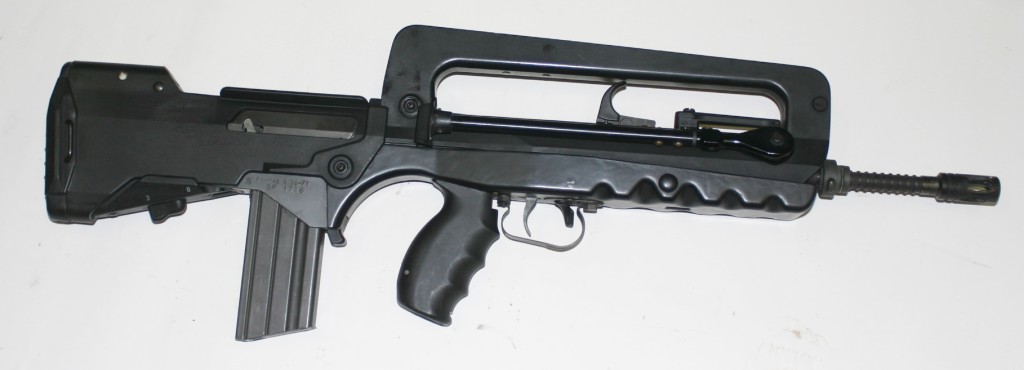
The FAMAS spent 9 years in development, beginning in the late 1960s and finally being adopted as the standard French Army service rifle in 1978 (replacing the MAT-49 SMG and the MAS 49/56 rifle). During this time, prototypes and 7 progressive variants were made (A1-A7) before finally settling on the F1 model for adoption.
Mechanically, the FAMAS works much like a San Cristobal carbine or AA-52 machine gun, using the lever-delayed blowback system developed originally by Pál Király. The bolt is not rigidly locked when fired, and immediately begins to move backwards. An “H” shaped accelerator lever is connected in the center to the bolt itself, with the bottom legs firmly against recesses in the receiver below, and the upper legs pushing on the bolt carrier. The accelerator cannot move back past the receiver lugs until it has rotated about 45 degrees, and its upper legs are longer than the lower ones. This forces the bolt carrier to move backwards much farther and fasted then the bolt itself can move. The time required for the bolt carrier to move far enough to release the accelerator lever and allow the bolt to move backwards is long enough to allow pressure to drop to a safe level in the chamber, and the built up momentum of the bolt carrier is used to cycle the action and load a new cartridge. A fluted chamber is used to facilitate extraction.
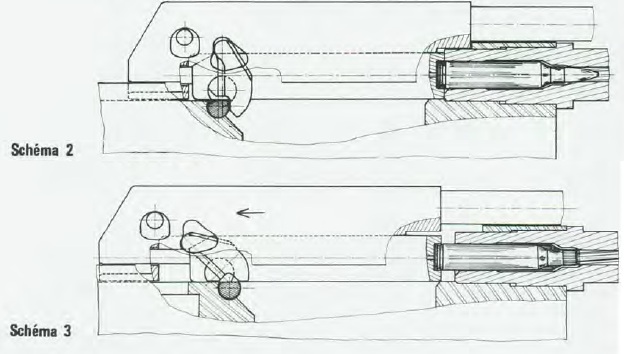
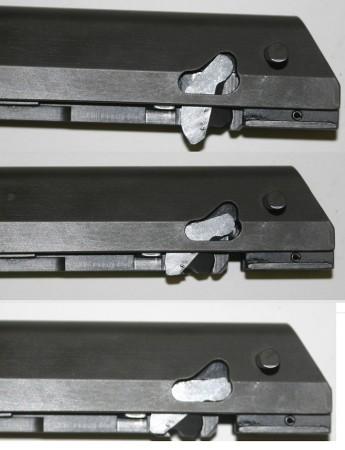
This system is fairly simple and negates the need for a gas system, but it does have limitations. It is really at the limits of a safe mechanism for a high-pressure cartridge like the 5.56x45mm, and does not have much tolerance for variation in chamber and barrel pressure. The initial F1 variant of the rifle adopted by the French Army was designed around the 55gr M193 cartridge, including a 1:12″ twist that is not compatible with the now-popular heavier 62gr and 77gr bullets. We have also been told (although not found confirmation) that the locking system itself is not overly reliable with heavy bullets, due to the difference pressure curve created by those rounds. The newer G2 and export versions of the rifle are built to run fine with heavier rounds (mainly SS109 62 grain), but the vast majority of Army rifles in use are still original F1 versions, which will eventually be replaced with a completely different rifle (the H&K 416, we understand) rather than reworking them for the new standards.
In addition, France had removed its military forces from the NATO union in the late 1960s, and the FAMAS was not designed around NATO standards, although it did use the same ammunition. Magazines were straight 25-rounders, not interchangeable with STANAG M16 mags (although this was also changed in the 1990s G2 version).
Unlike many other bullpup rifles, the FAMAS was not built with optics mounting in mind – it is equipped with iron sights inside the top of its carry handle. These are enough to get the job done, but not particularly outstanding. It is worth noting, though, that both the front and rear sights are actually mounted to the barrel and receiver, and the carry handle mounts around them. This does improve accuracy, as slop in the carry handle mounting will not translate into movement of the sights.
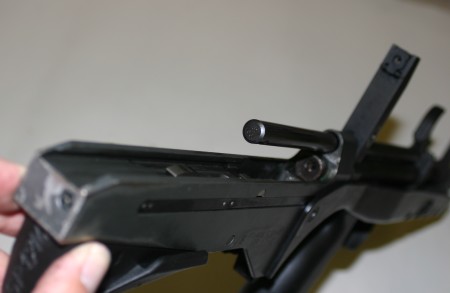
The fire selection leaves something be desired. The rifle has a safety lever inside the trigger guard, which rotated from left to right. The right (marked “1”) is for semiauto fire, the middle position (which physically blocks access to the trigger) is for safe, and the left (marked “R” for “refale”, or burst) is for automatic fire. That automatic fire can be either full-auto or a 3-round burst, as dictated by a second selector located under the buttstock. That one has markings of “0” (for unlimited full auto) and “3” for 3-round burst. Today burst firing has pretty much been determined to be undesirable, but it was still though to be a neat idea when the FAMAS was being designed.
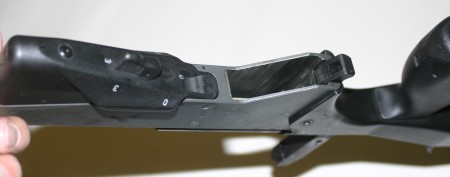
Most notable for an early-adoption bullpup, the FAMAS can be fairly easily changed from left-handed to right-handed use. The charging handle is entirely ambidextrous, located atop the receiver inside the carry handle. The bolt is made with cutouts for the extractor to mount on either the left or right side, and the receiver has ejection posts in both sides. The desired ejection port is left open and a detachable cheekpiece is mounted over the other one, and the extractor is fitted to the ejection side of the bolt. To switch the rifle’s ejection side, the extractor and cheekpiece are simply moved to the opposite sides. This is not practical to do in combat, so the rifle can’t effectively be juggled from shoulder to shoulder, but it does allow lefty shooters to use the rifle without handicap (and without needing to have any lefty-specific guns or parts).
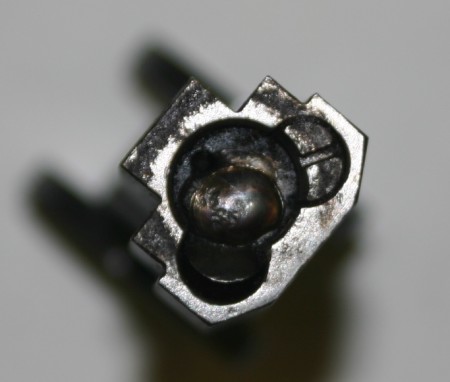
One other feature to note – the lever in front of the charging handle is actually a grenade launching sight. The FAMAS was designed to use 22mm rifle grenades that slip over the barrel. To aim them, the rifle is laid on its side, and that lever is flipped out to a detent setting based on the desired range of the grenade. The firer then sights down along that lever at the intended target.
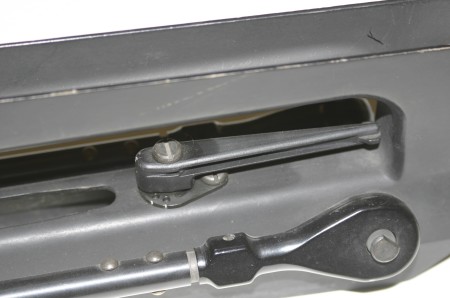
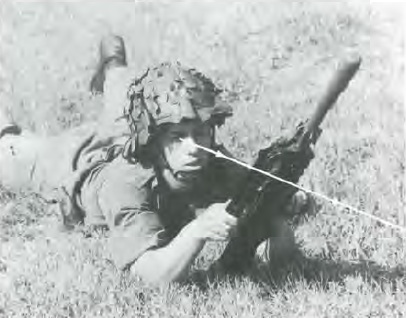
Manuals
We have two manuals available for the FAMAS, one in French and one in English (both describing the original F1 variant):
FAMAS F1 manual (English)
FAMAS F1 manual (French)
Photos
You can also see the full gallery of photos (or download the whole batch here as a zip archive):








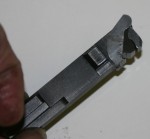
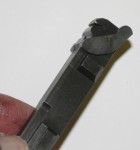
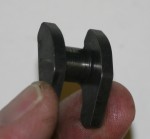

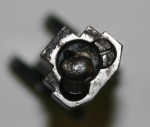




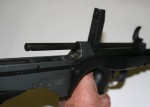











The french may be innovative, but their designs rarely turn out positively.
I am french. As a former officer, I agree with you. And the price ! Jean-Louis
Though I heard that they fixed most of the problems present on the F1 on the new FAMAS G2 rifle. I’ve also heard that it has been adopted as the mainstay rifle for the French Navy & French Marines though the French Army is still holding onto their F1’s for reasons I don’t know. I might venture to guess that cost might be a factor. Plus I always wondered why DuGalle got all pissy with NATO.
Well, it’s mostly because we (the US) said All of NATOs nukes had to go into the pot, and the French said “Ahaha… Non.” and did their own thing
I haven’t been able to find if this gun is hammer or striker fired. I would like comfirmation on this point.
It’s hammer fired.
Why was De Gaulle “Pissy” please put yourself in His shoes , it goes back to WW2 while forming free France movement,the US send via a submarine in the mediteranee sea a secret “they thought ” diplomatic and military mission to negotiate with Vichy and the Nazy …that dis not fly very well , later when Nato was created it was nothing but an extention of the US , De Gaulle wanted none of it and got France to develop, the nuclear bomb and the missile to deliver it just about anywhere , including the soviet union , it paid out . sadly the program was basically dismantled by the socialistes …..
Degaulle also wanted the US to use a nuclear bomb at Dien Bien Phu, wiping out the Viet Minh that had concentrated there (and the Foreign Legion defenders too, but hey, its the Foreign Legion! They don’t vote!) The US declined to do so in support of Vichy French colonialists demanding back payments for the time that the Japanese were in occupation, rather supporting Ho Chi Minh, who had been a US ally in WWII, and who had helped recover US pilots.
The Viet Minh 105mm artillery at Dien Bien Phu was of US make, and had been transported from Korea, where it had been captured during the Korean war.
Does the famas have a fluted chamber, i cant seem to find information on this and the two manuals contradict themselves (the french saying it has a “fluted chamber” an the english a “rifled barrel”)? The famas apparently has several issues regarding the extraction of brass cases forcing the french army to used steel cased cartriges with a bullet inadapded for the twist of the rifling, which causes a severe degradation in accuracy as well as supply complications. The extraction problems seem to be caused by the extremely high rate of fire and a violent extraction cycle (this last one, common to unfluted delayed-blowback designs). I wanted to know if it is solely due to the high rpm or if it can be improved on by fluting the chamber. if you had a stock photo it would great ^^. thanks in advance.
Anyone know where I can get a Famas receiver and barrel? Just found a kit for sale
I was an American in the Legion. I don’t know too much about guns but this gun always worked. I never had a problem with it.
I was in the Legion and I fully disagree! FAMAS has loads of stoppages due to excess of gas in the chamber, loose mags (very poor quality FMAS mags), dust around the chamber, and the list goes on and on. A true weapon is a weapon that you can deploy in the worst conditions and needs no cleaning for the duration of mission, especially if you don’t fire the weapon. Overall, FAMAS is a shit weapon.
I was a legionnaire for 5 years in the 2 REI and carried the famas in the 80’s.It was a very reliable weapon in all conditions.The rifle’s blow back system can handle nato rounds which we were issued and fires high pressure rifle grenade blanks.The only complaint I would have was it’s high rate of fire on full auto,1000 rounds per minute,emptied a 25 round magazine in 6 bursts.
The FAMAS is not good! About years, I can say the best weapon is a russian AK-47, this gun is the best, ever.
I like AR-15, AR-10, FN-Herstal FAL, Colt, but these machines are not good like AK-47.
Anyway, there are no good machine if the soldier can not carry yourself.
It does means, if you clean your machine and repair constantly, your machine will work as a good machine.
And at French Foreign Legion, we are always cleaning our machine, cleaning, repairing, what ever, as a same as Navy Seal, but anyway, there are no better machine as AK-47, Water, Desert, Forest, Ugly and Dirty, always working…
i’m french and i don’t talk english well, so, if a french guy can translate what i’m say, it’s nice. l’AK-47 est efficace niveau cadence de tir et puissance mais le FAMAS est plus précis je trouve, après, c’est peut-être moi qui m’en sert mal, mais j’accroche pas trop a l’AK-47, bon après moi, j’utlise plus souvent les armes lourdes, du genre du 12.7 ou du 14.5 (ce dernier, je l’utilise très rarement), merci de votre attention.
Here is, at last:
AK-47 is efficient for rate of fire and power but the FAMAS is more precise to me, but maybe it’s me that don’t use it properly (the AK) (TN: no it’s not you…), but I am not very found of the AK, I mostly use heavy weapons like .50 cal or 14.5mm (very rareley for the latter), thanks for your attention.
Many thanks for this informative article, and thanks for this interesting web site.
In general, a lot of french engineers tend to like inovative and elegant solutions, the are a bit perfectionist in their own way and a lever delay blowback action is both a the same time. It is ingenious and there is some kind of beauty on a system that cannot be understood even a drawing or stetches or any visuals, you need knowledge (just like quantum mechanics). So, starting from strach in the 70’s, there was no reason not to adopt this system as it is no bad or better than any other.
The is a lot of comment about what a lever delay blowback action can and cannot do, all usual pros and cons that is supposelly attached to this mechanism. I think the is a common misconception about how we can evaluate a technical product. There is a general tendency to misunderstood a principle with its application. Every design engineer is very aware with this distinction because it is the core of it’s job to find out a proper way to implement a principle, a technical solution, that’s all engineering is all about by the way.
Usually we read about:
The weight:
if tou take most “long” barrel rifle (around 19.2 to 20″) made in the 70’s made of the same kind of material.
At 3,61 kg (7.96 lbs) the FAMAS F1 is in the same range that many gas operated rifle:
in bullpup SA80: 4,13 Kg and Steyr AUG: 3,8 Kg
in roller delayed HK G41: 4,1 Kg
and
M16A1: 2.89 Kg and later M16A2 3,77 Kg
AK74: 2.97 Kg and later AK74M: 3.4 Kg
FNC: 4,06 Kg (FN CAL was lighter at 3,0 Kg but there was issues)
HK G36: 3,6 Kg
Beretta AR-70: 3.8 Kg
SAR80: 3.7 Kg
SIG550: 5.05 Kg
The twist:
Usually the more you asked to a mechanism, the more you have to do to make it work such as high tolerance, good alloy & materials.
The FAMAS F1 was design from the begining for a certain weight and a certain type of cartridge just like any other rifle. Even an increase of 10% is enough to have to change a lot of component in many rifles and from 55g, 62g and then 77g is a lot.
Remember the M16, the original AR-15 twist have to change from 1:14 (for 53/55 grain) to 1:12 just due to atmospheric conditions and when it have to change from M193 to the M855/SS109 (62 grain), the M16a2 take a 1:7 twist.
Extraction and curve pressure:
The extraction problems the FAMAS F1 occurs doesn’t seems to append before the change of manufacturer’s cartridge, after the closure of the french plans, purchase has been made overseas. If you fire a badly made round on a rifle (or even a round not exactly designed for this rifle), the is a good chace that it will not go so well.
Sensitivity to the specific pressure curve design:
It is sensitive for sure, just just like any high performance automatic mechanism, I put aside the Maxim machine gun and alike.
A gas port automatic rifle may have a lesser sensitivity with a gas port valve like the FAL for instance. But what’s the point to argue about the supposed insensitivity of the curve pressure if you don’t have any setting like the M16 and so you have to change the whole assembly of buy a new rifle more conveniently for the seller if the cartridge change.
Nobody complain about the sensitivity of the M16 when they change from M193 to M855, they just buy new ones.
The next time the french army (and the same for the others) will have to change the ammunition, what kind of solution they have to figure out beside pass an order to HK and wait again 10 years for 90 000 rifles ? (at $4800 piece ! who said the FAMAS was expensive ?)
For the pros, you just have to shoot a box of 5.56 and you’ll see by yourself.
By the way, the TKB-517 was considered and usually had very good rating after extensive test, even better than the AKM, more accurate,better control on automatic mode, less expensive and no gas port to clean.
In conclusion, lever delay blowback action might be consider as a good technical approach and the FAMAS is a good example of this.
Have a nice day.
arndebian, thanks for your knowledgeable clarification on the supposed short comings of this very good looking rifle.
With regard to the M16/AR-15 design and changing ammunition.
You can and they did modify the buffer design and can change the buffer weight and spring strength. The gas port is not adjustable but the size of the port is different depending on barrel length. I have heard of ammunition having to meet not only a maximum pressure limit but also having to meet a specific port pressure range in some contracts. It is quite possible to shoot .223 or 5.56 ammunition in a civilian AR-15 reliably from 45 grain varmint loads through 77 grain open tip match without making changes to the gun. The accuracy will probably have a sweet spot among the bullet weight but the gun will cycle them all.
I think arndebian’s point was about service rifles with service ammunition rather than individual civilian guns. A civilian gun can and will shoot a wide variety of ammunition in its life, and the owner can do a lot of modification and tuning to accommodate it, improve reliability, adjust sights etc, but a nation’s 200,000 or 2,000,000 service rifles stand a good chance of only ever shooting a single type of ammunition within a certain predictable spec. If there is a change in ammo, it’s probably cheaper and certainly quicker to simply replace the tired rifles with a modified or new design than to pay armorers to tune and recondition the entire stock.
The lever delay system works because the lever is working at a mechanical disadvantage. It is similar to the “accelerator” in the Ma Deuce. This means that when the bolt is pushed back a small mount the larger mass must move further and faster so it acts like a much more massive bolt in a straight blow back submachine gun. So the FAMAS works like a straight blowback machine gun with a very massive bolt.
In Paris two years ago I saw some soldiers carrying the FAMAS with a forward pistol grip with a couple of push buttons and a small screen. I haven’t seen any mention of this feature anywhere. Also I watched a Youtube video of Foreign Legionaires training with FAMAS with a forward grip and a flat bar joining the front grip to the rear pistol grip. Any information about this? Look at 8:43, 8:46, 8:53, and 8:59 in this video. https://www.youtube.com/watch?v=KLHodD4Fqk8
It’s FELIN, the French system for a connected, digital system. The rather outdated Wiki article: https://en.wikipedia.org/wiki/F%C3%89LIN
Since that was written, the French appear to have decided the system is too expensive and heavy. And, of course, they’re switching to the HK416. Presumably they’ll try again with that.
I m French, ex army and can give a proper advice about FAMAS F1 reliability , as i was personally involving shooting hundreds of different FAMAS rifles, on the field and as range officer , was monitoring firing of thousand of rifles with all sort of soldiers, experimented or not, professional or conscription poormotived guys as well during 10 years. I will not speak of F2 or G2 FAMAS, as i never use them, but i have handle a lot of other assault rifle other the years, and shoot the most common of them: G3, Beretta, M4, FAL, AK 47, AK 74 as wel as LMG and MG’s…So i have by experience a decent idea of what it good and what is not good about assault rifle, and not only theorical figure…
I first enlisted in the late 80’s, make some use of the FAMAS F1 of very first production,then come back to the army for 10 years from 93 to 2000 and use the gun on a daily basis…In the 80’s i was first shooting MAS 49/56 as standart issue in this days: this was used and worn guns, some of them still in use from algerian war, and overcleaned and tortured by hundreds of soldier: they were still working well, reliable, we don’t have problems execpt from worn out mags, accuracy was not excellent from worn out rifle but still decent to kill somebody at 300 meters . Every soldier perform with a couple of cartrige… Then FAMAS F1 was available and we switch to them: the very first we used were allready worn out by intense range shooting from years: we look at them with defiance first:
_ first look to FAMAS F1: i was in the idea that this light aloy aluminium and plastic thing will easily break in parts, and will not make 25 years of continues service as the MAS do ( a MAS 49/56 can verticaly fall from some meters without beingdamaged, never see one damaged to any point other than cosmetic after falling from a truck or whatever…), that the tiny barrel will easily bent, that the gun will overheating and worn rifling after a couple of full auto mags , and so on…
I was wrong: after 10 years of daily use in all possible condition, i never see a real damaged FAMAS F1 except from some scratch and some plastic parts lightly damaged, some fiberglass forehand craked, but still workable, just looking bad. I see plenty of rifle falling down in every possible height or position, from truck, on rocks, throned by accident, some stepped by man in the night and other: i never see a butt damaged, i never see a bent barrel; I remember a soldier jumping from a truck with the rifle close to the body from the strap, the barrel engageaccidentally into the truc dor openning, the soldier stop in the air by the barrel rifle fix into the truck,hang up and almost killing himself, banging back the truck side and finally everyting crashing down: we all think “barrel bent, rifle dead”, lokk at the rifle: looks right; fire the rifle, shoot straight, and was not the only one to reports some other similar case.
I never have a FAMAS , what ever happen, that refuse to shoot: it never happen.
The only extraction problems with have were from damaged rounds, as we collect them and orce them into the chamber to avoid to bring live ammo back ( the standart use, when you shoot at range is to never bring back live ammo, what ever the reason, the “infantry” tradition is to shoot all…) I currently load round by round badly damaged ammo, bullet into the case, or making a bad angle with the case that by normal rules were of course never to be put into a gun: but we routinly shoot these: remember they are steel case, not as soft as barss case: to chamber such ammo you may have to release the bolt 2 or 3 time to force it to the chamber and be able to fire; of course it make an over pressure: i never have a problem anf perform shooting damaged ammo during 10 years execpt maybe 2 or 3 so damaged that impossible to fully chamber…Nver have a sign of overpressure . Usualy extraction works fully, exceptionnaly damaged case struck in chamber halfway: press the charging handel and bump the gun on floor, extraction done. Exeptionally, maybe one or two time in 10 years case still half way struck and fater several bolt move by force, case rim damaged: easily solved, one or two minute: remove stock and bolt and reverse extractor from right to left or oposite to have a non damaged rim case side and move the bolt back again; Other option, using a metal rod ( always one available somewere in a truck…) and hammering on, problem solved. I never see an extraction problem with correct ammo, execpt if chamber with sand, whatever the chamber was clean or very dirty. We fire commonly the end of all loaded mags in the same gun whatever the quantity of ammo left to close the range on time, full auto, mags after mags in the same gun, i remember firing currently up to ten, barrel color become strange and bluegrey, never have a chamber, extraction or overpressure problem, never have to change gun….And rifling still fine! In 10 years i never bring back a non working gun to the armourer. It simply never happen.
Water in the barrel may cause damage: soldier were train to check the barrel before firing, and have a rod or a string to clean if they have time to do, or just open half the bolt to drain before firing; never see a crack or dump into a barrel in years of weapn inspection. I see rusted barrel, worn out barrel, blackened parts along the rifling: accuracy checekd and still into a head size at 300 meters…
I see barrel who have been shoot with real bullet when blank firing attachment in place: No damage to the soldier, BFA just disapear somewhere as a missile with the flash hider, never find them back… The thread of the barrel end was worn out, but the rifling and mecanism still intact, no cracks, no visible oversize of the barrel: the gun was still in working order, to be turned to the armourer for repair and reports.
We fire grenades as well, by dozen. They are heavy and the propelling cartridge have A LOT of power.Indirect fire, the stock is on the earth and take the shock: never see a problem. Direct fire ( antitank…) you aim at shoulder; you have to be carefull and put the head back:allmost every grenade launch damage you shoulder and bring the handguard right on your face, noise . See plenty of soldiers with cuts, and strange color on face with extra size, never see a rifle stopping service during grenade launching.
So reliability: yes, no problem . Never see a serious issue…
Accuracy: yes, whatever the soldier, condition and age of the gun, a head at 200 meters and upper part of the bodu=y at 300m ; Everybody perform with 5 cartridges, and trained soldiers can make 5 kills without problems ;Form MAS 49/56, every soldier reduce the dispersion by half. What you can shoot at 200 meters, you can make the same at 300 meters with a FAMAS. Accuracy on grenade direct fire depend of the strongnest of the soldier, and frankly it’s a very unpleasant experiance, but you can destry a tank with the AC 58 grenade, for real it punch 40 cm of armor plate. Accuracy in indirect fire is incredible, up to 340 meter, after 2 or 3 grenades all soldiers perform well:it’s equivalent to a light mortar, and there is no limitation of rifle life launching grenades: you can launch as much as you want, never damage the rifle or accuracy. Axept Serbian AK47, i never see any standart assaut rifle able to be used as a real grenade launcher without restriction with heavy grenades; usualy it’s a option who has to be used on a limited bases to not damage the rifle; FAMAS are made for beeing used as a grenade launcher and can be switch to normal assault rifle at any time.
Perfect weapon: no, FAMAS F1 has issues, especially first production: The stricker were easily separate from it’s base when push by hammer. I remember in the 80’s strickers heads falling free out of the barrel when working order checked on unloaded gun. It was solved by a proper crimping or glued, i don’t know, but i never see this again in the 90’s; It was solved for ever. Cheek piece was 2 piece construction, easily broken or lost. Replaced by one piece plastic new one, sometime fall apart after a shock, put back in place in one second, and change when worn out …problem quickly solved at no cost. Very old FAMAS may be worn out at a point that the junction rod between trigger and selector was damaged and do not trigger in 3 shot limitation: make one or two in place of 3… usualy reasult of bad manipulation with prohibited tools ( like a knife blade) during cleaning; Gun to be repair, but in fact it still shoot in shot per shot or full auto…
Cleaning: french army love spending hours and days in gun cleaning: as the FAMAS is full of cavity you can ensure having the soldiers cleaning for hours and by quiet they will not make anything silly or stupid this day….Cleaning famas for hours is a sort of tradition and soldiers hate it: i now how to find dirt in the most ever clean FAMAS. But technicaly this cleaning are useless. The gun still work perfectly even with dirt everywhere inside, tehre is a LOT of place for dirt, without interfering to mechanical issue; As long as the chamber is clean from sand and the selector not stuck by sand or gravel, there is plenty of space for the dirt to be push apart and let the bolt work. return spring is in a life sealed chamber, never see a problem with this part. The army rule say: on combat clean your FAMAS once a week only: barrel, chamber, mag and that’s all. if fired, use rod and clean rifling. Once a month remove the bolt , bolt head and clean it, put a drop of oil. That’s real and the handguard can stay in place for month. The the cleaning issue is just a barrack thing. FAMAS stay relaible even if dirty. Of course if you have mud, sand or gravel entering chamber or bolt parts, you have to clean it, like all gun in the world. And it’s the same with an AK…
Dismounting the gun is not as easy an a AK. That’s true; removing parts from MAS 49/56 take me 6 or 7 second in the 80’s, stripping a FAMAS may be 30 to 40 second at least…But at field you need only to removethe stock to access and clean:that’s quick. No small piece to be move apart, nothing fall in the grass… The only delicate tiny parts is the bolt head: At field there is no reason to do except once a month.You can drop the tiny parts into the grass and b=never find them back. That’s true: But there is no reason to do so if not at day in a quiet place. All soldiers are trained to strip the bolt head on a proper way, and not at a silly time, night, combat, mud…There is a time to do and a way to do:other a visor cap or a beret: trained soldiers don’t loose any parts of their gun: i never see this exept one time when cleaning and and stripping on the open back of a moving truck, a very stupid idea whatever the gun. And in combat every soldier has with the cleaning kit a replacement kit with the 3 little tiny parts of the bolt as spare. So FAMAS tiny parts are amazing and don’t exist in other assaut gun, but in practice it never become a problem.
So if the gun work and is well design to do so, what can be the problem? The two real problems of the FAMAS are: proper ammo and proper magazine: but that’s the same with all guns: if you shoot damaged cartridge: you may have a problem; as explain FAMAS can do it to a certain point, will not be damaged and extraction problem can be cleared in couple of second; So jamming can be cleared easy and are not related to powder gaz, over pressure, flutted chamber , but to damage case or sand parts only. Like an AK.
The second ammo problen is improper ammo: FAMAS was design for a variety of early .223 national produced in france, with economic steel case and not with later upgraded ammo. As the ammo industry collapse in France from corruped governement, French army use steel case natinal produced stocks until now in war, and buy extra ammo to otehr country for training to save the good ammo for real things. Purchase are non standart ammo to national standart, whatever tehy come from, as actual NATO standarts on .223 were not existing when FAMAS was tested. So using ammo not made for in a gun result in general failure, no more accuracy and jamming problems. That’s one of the reason of replacement by a NATO standart gun: no more proper ammo designed for FAMAS available in the futur. Exept for this, FAMAS are commonly over 40 years old of daily service and still reliable with what is left of national made correct ammo; I never see a early version of M16 in service anywhere, replaced by M16A1, A2, M4 and so on, upgraded . Do early M16 perform well with actual NATO .233? I don’t think, it was not designed for. M4 ? yes, it’s made for. Same with FAMAS: There have been no major mechanical update on FAMAS F1. They have been in use during dozeen of years without any mechanical change. The FAMAS used today are the very same i was be given to shoot in the 80’s or the 90’s. Retrofit are cosmetic only. They are reliable, that’s no point about.
So if stoppage occurs, like all weapons, the responsible is: bad magazine.
That’s true and not true: the 25 rounds mags were design as expendable, and work pretty well : in good condition, this expendable mags can be reloads hundredes of time: and that’s what happen: in barracks life they are not expendable but reused over and over … and damaged when the soldier go to the field: at shooting range damaged mags made improper introductions. When proper officer and skilled soldiers are around this damaged mags are take apparts and turn over to the armourer; they will be put in form again by hammering on a special anvil, and back in service for years, until they are worn to a point that repair is impossible: at this point they will be destroyed and replace by new one; As long you use new mags or proprer overhauled mags, as long as you have soldier and officer who care about mags and follow replacement, your gun run and is reliable. If nobody care of check and repair the “expendable” mags you end with damaged mags only and your guns make stoppage every time. But indeed the expendable mags, when take care off , can last for years of use…Stopping are not permanent jamming and the gun can be reload very quick with a proper mag. As using the old mags in normal service, there are plenty of of new mags in stock: when you go to war, you take new mags, and you dont use them as a hammer to braek stones, you don(t step on them, you don’t seat on them or to open bottle of beer with the lips of them. And then your gun works when it’s need to.
It’s a good gun, no point about this, people who say different have not used it on a proper way, that’s all. But you have to keep in mind that a FAMAS can not be equivalent to an actual NATO standart gun: NATO ammo, NATO mags, this standart where not existant in the 70’s. You can not make any conclusion by data with a AK 47 or a M4: all these guns work proper if you know how to use them, but AK use a 7,62 round and FAMAS an old generation of .223:that’s not the same thing, depending what you shoot at…If you need extra penetration, take an AK ! But the FAMAS can make a direct grenade launch other 40 cm of armor at 100 meter and an AK round can not.That’s just different things, you need them, or not! FAMAS and M4 are in the similar class of ammo and accuracy, but FAMAS is a grenade launcher by construction and M4 is not: if you want to use rifle grenade capacity, FAMAS F1 is the best, FAMAS F2is not made for and if you don’t have any grenade you will make the same work with a M4 without FAMAS extra weight and a lot more easy to handle, so take the M4…